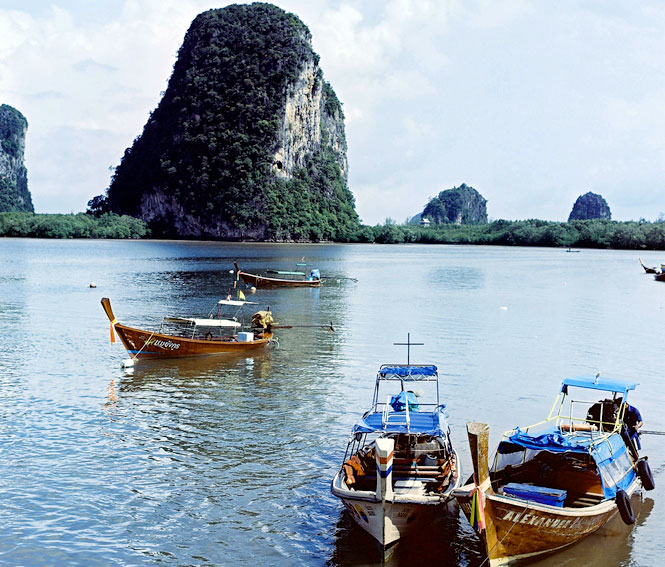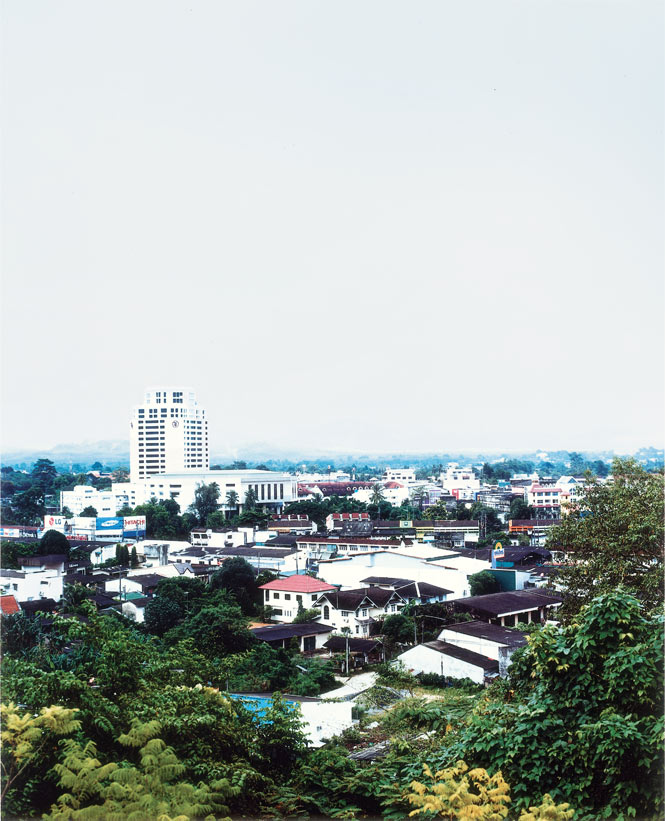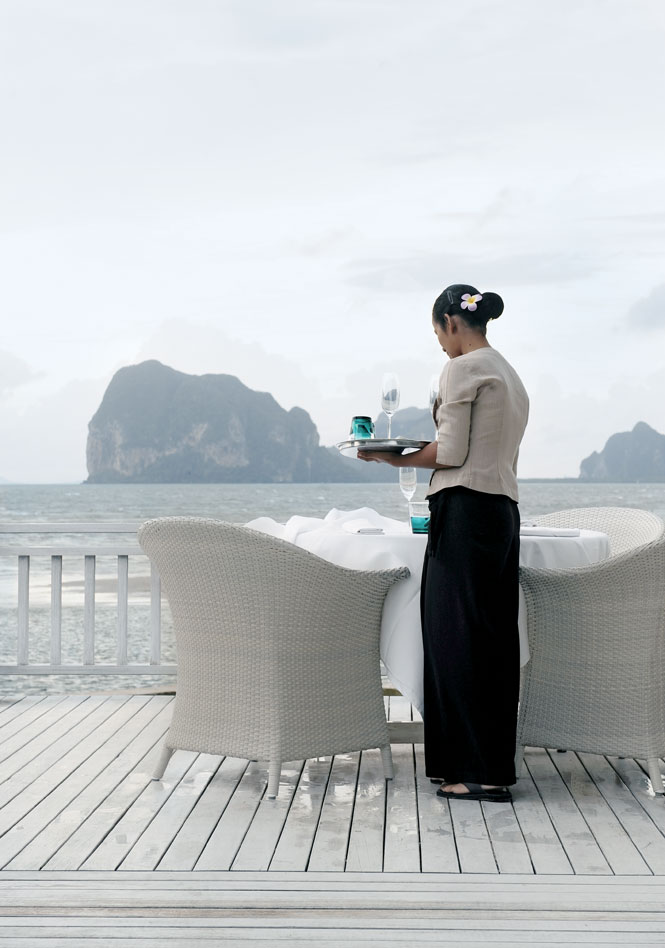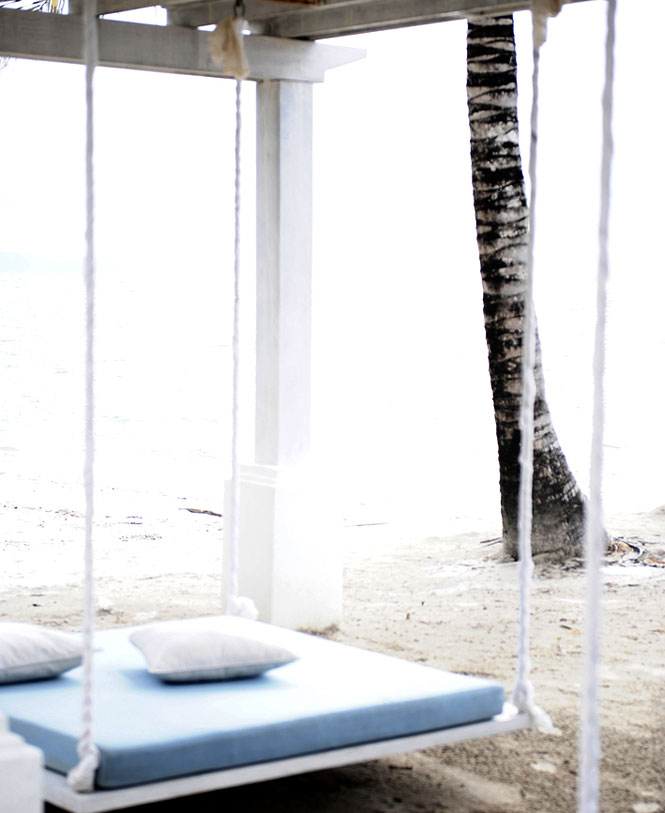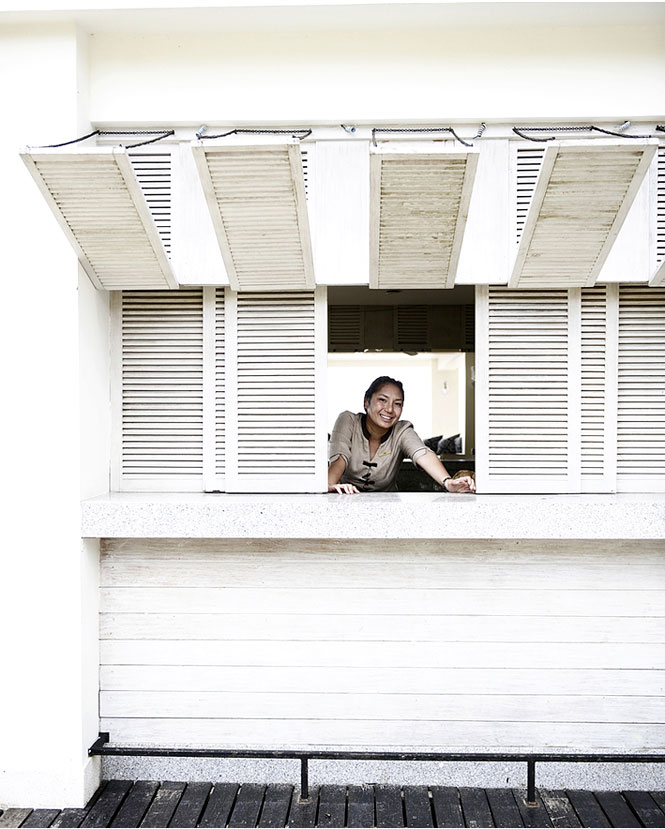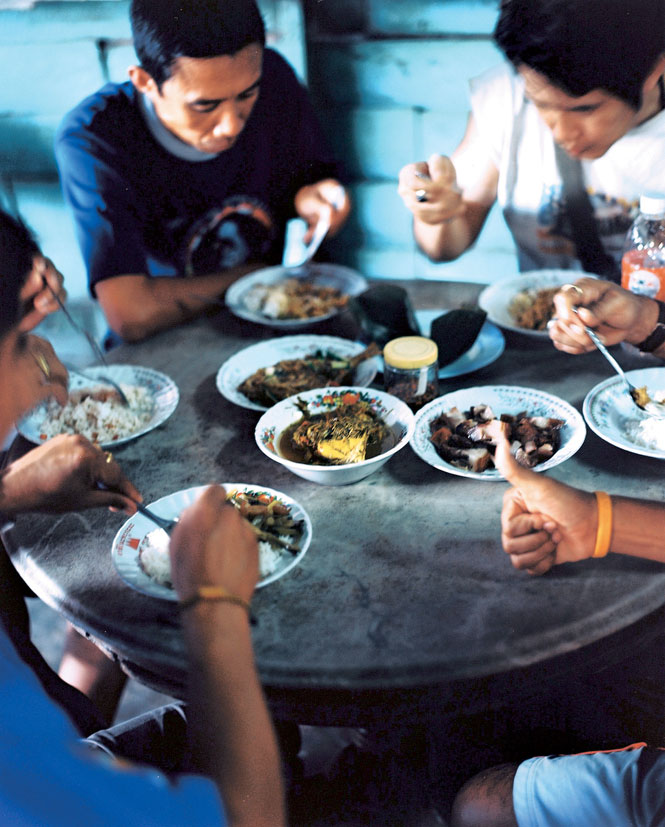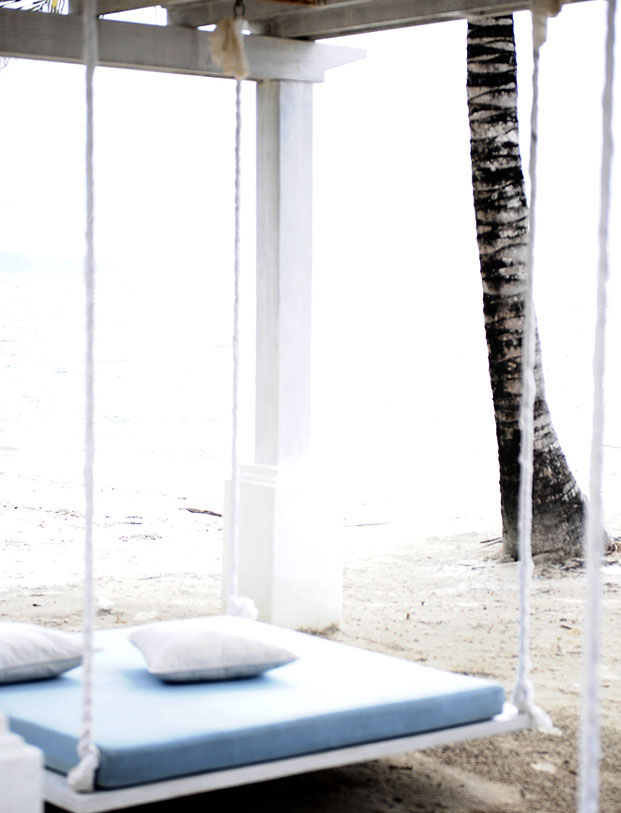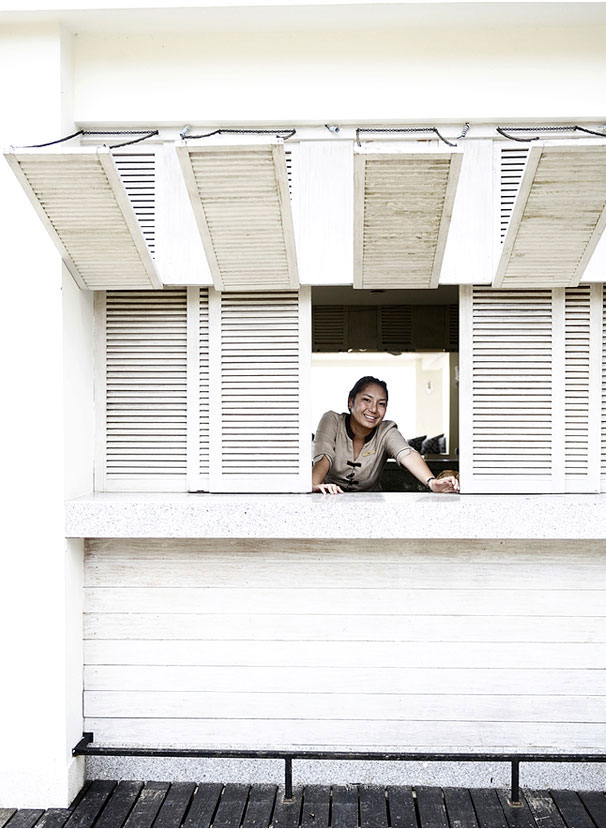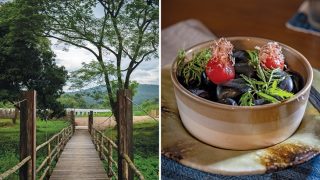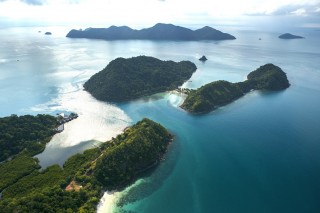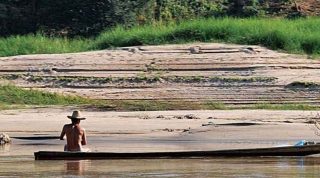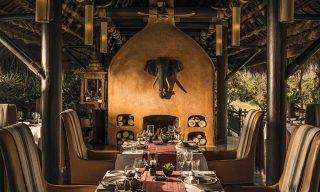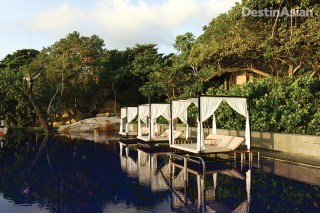Above: Longtail boats like these ferry travelers to Trang’s islands.
Natural Selection Phuket and Krabi may draw the crowds, but just down the coast in Trang, savvy travelers are beginning to discover another, gentler side of southern Thailand
By Christopher R. Cox
Photographs by Jason Michael Lang
After a half-hour crossing from the mainland, our longtail boat drops anchor off Koh Mook’s Charlie Beach, a sparkling sweep of fine white sand backed by rubber trees and a scattering of sedate bungalows. There’s no pier, so I slide hip-deep into warm, startlingly clear water and wade ashore with a duffle bag balanced on my head.
If there were a Thai witness-protection program for natural landscapes and unaffected local people, it would be set on the shores of Trang, a fascinating coastal province more than 800 kilometers south of Bangkok. Elsewhere along Thailand’s Andaman seaboard—in Phuket, Phang-nga, and Krabi—life now moves to a faster, more tourist-oriented beat. Yet Trang, just over the horizon, remains practically terra incognita for foreign travelers, thanks in part to a minuscule airport served by only one flight a day from Bangkok.
“It used to all be like this,” says Atichat Mukda, the 50-year-old manager of Koh Mook’s Mayow Thai Kitchen restaurant, waving his hand vaguely in the direction of Phuket as we share a plate of stir-fried cashews. “Very slow.”
Slow it is, but that languid pace only hints at Trang’s appeal. From the vantage of an inbound Nok Air plane, the province’s natural bounty and adventure potential unfold in a vista of forested mountains and thick rubber plantations, meandering rivers and offshore limestone islands. Trang is home to dozens of waterfalls and limestone caverns, including Tham Le Khao Kob, whose four-kilometer underground river can be explored by kayak. Broad estuaries fringed by Thailand’s largest remaining stands of mangrove cleave a gorgeous, almost undeveloped coastline that stretches nearly 200 kilometers along the Malay Peninsula. Sea-grass beds off Koh Libong support more dugongs than anywhere else in the country; farther afield, there are nearly four dozen other islands, including sleepy Koh Mook and coral-rimmed Koh Kradan.
Though now overshadowed by Phuket and neighboring Krabi, Trang served for centuries as an important overland trade route between the Andaman Sea and the Gulf of Thailand. Once part of an ancient Malay kingdom (its name is a corruption of terang, the Malay word for “dawn”), Trang grew even richer after governor Phraya Ratsadanupradit Mahison Phakdi imported the first rubber seedlings to Thailand in 1899 and planted them in Kantang, then a thriving seaport that doubled as the provincial capital.
Chronic flooding would later shift the capital 24 kilometers inland to Trang City, but not before a spur of the Southern rail line—in service to this day—was laid all the way to Kantang, some 854 kilometers from Bangkok. A vestige of faded grandeur remains in the old town, where family-owned shophouses built a century ago are fronted by colonnaded galleries—the “five-foot ways” so common in Singapore—and where the gracious, two-story wooden residence of Phraya Ratsadanupradit has been preserved as a small museum.
More-modern architecture lines the spick-and-span streets of Trang City, best known among Thais as the birthplace of Chuan Leekpai, who in 1992 became the first Thai prime minister to assume power with neither military nor elitist support. Trang can also claim the most stylish transportation in the kingdom: the tuk tuk hua kop, or “frog-head tuk-tuk.” Here, the three-wheeled taxi features an enclosed cab with bulbous headlights and a curving bonnet that is often adorned with a knock-off Mercedes-Benz hood ornament. All that’s missing is Mr. Bean behind the wheel. However, the province’s biggest bit of wackiness is the Trang Underwater Wedding, a matrimonial stunt conducted every Valentine’s Day in the coral gardens off Koh Kradan.
And then there is the food. Forget about a hotel breakfast of Nestlé’s 3-in-1 instant coffee and tinned sausages; Trang has a national reputation for its fresh-brewed ko-pii and moo yang (slow-roasted pork in a marinade of honey, garlic, and assorted spices). Be prepared to snack all day on Lam Phu Ra cakes, a sponge-like confection filled with local fruits and named for the village where they are commonly baked.
A more dubious distinction: it rains in Trang. A lot. If the extended downpours shorten the tourist season, they also keep the fields and forests and rubber estates a lush green. And it is this relaxed, rural ambience, coupled with the tolerant attitudes of Trang’s inhabitants, that appeals to travelers looking for a deeper, more authentic cultural experience.
Above, from left: On the terrace of the Anantara Si Kao resort’s Acqua restaurant; The Anantara Si Kao’s lobby; A daybed at the Anantara resort; Service with a smile at the Anantara Si Kao.
“You don’t have all the tourist trappings here,” explains Mark Hehir, general manager of the Anantara Si Kao resort, a luxurious seaside property that opened in late 2008 within Hat Chao Mai National Park. “It’s off the beaten track, but that’s the appeal. If you want to sit like a sardine on the beach, you can do that anywhere. Trang is all about that local, natural feel.”
But there’s bound to be an identity problem when the province’s premier hotel bills itself as “Anantara Si Kao, South of Krabi.” The branding isn’t meant as a slight, however; it’s just good business: while the Anantara is situated in Trang’s Sikao district, the location is barely more than an hour’s drive from the international airport in Krabi.
Among yachtsmen sailing between Phuket and Langkawi, Malaysia, the Trang coast has a stellar reputation. Bill O’Leary, author of the Andaman Sea Pilot, ticks off the draws of this cruising ground: limestone and granite islands; varied underwater terrain, including healthy corals, for divers and snorkelers; pelagic fish species and dugong; and water “that’s just gin-clear and bloody beautiful.”
Koh Mook, an eight-square-kilometer island with a population of about 1,600 Muslim fishermen and rubber tappers, is also home to one of the Andaman seaboard’s most outstanding natural attractions: Tham Morakot (Emerald Cave). While the karst outcrops of southern Thailand are riddled with caverns, there is nothing to rival this singular sea cave.
At Charlie Beach, I board a fishing boat and motor north beneath sheer limestone cliffs that rise almost 100 meters above the sea. Before long, the boatman ties up to a mooring ball near the entrance to a 10-meter-wide tunnel at the base of the towering mountain. I grab my snorkel gear and slide overboard. The tide is falling, and a tracery of sunlight dances on the tunnel’s sandy bottom, illuminating schools of sergeant-major fish. Then everything fades to black. With the help of a waterproof flashlight, I swim for another 80 meters through the S-shaped passage, until the dark water begins to glow an emerald green. I’ve arrived at a hong (literally, “room”), a lagoon scooped out of the limestone by millions of years of rainfall. As I wade ashore, I’m astounded by the vine-draped, in-the-round cliffs that give Tham Morakot the look and feel of a prehistoric atrium. And while most of the hongs I’ve encountered in southern Thailand possess muddy bottoms and a mangrove fringe, this one has a creamy white beach—perfect for kicking back and regarding the small disc of skylight far overhead.
Tham Morakot attracts tour boats from as far away as Krabi province’s Koh Lanta, though most visitors see nothing more of Koh Mook than the daunting sea cliffs on its west coast. Yet the island has a seductive, chill-out vibe. Beyond a cluster of small resorts on Charlie Beach, the orderly rows of rubber trees—from which the island derives its chief livelihood—have largely stood their ground. I follow a dirt track past their scarred trunks to a saddle in the hills, where a siren-equipped disaster-warning tower pushes above the canopy. Because of its buffer of offshore islands and coastal mangroves, only a handful of people in Trang perished in the December 2004 tsunami, among them two Malaysian tourists trapped inside the Emerald Cave when the wave struck. In Ban Koh Mook, the island’s only settlement, a blue metal marker indicates the surge’s high-water mark: 2.5 meters above sea level, enough to wreck many homes and boats.
“We ran up to the mountain,” a local woman tells me of that fateful day. “We stayed there four days.” The village soon rebuilt. And a new boutique property, the 37-bungalow Koh Mook Sivalai Beach Resort, rose on a sandy point just beyond a working strand where fishermen offload their catch or repair their boats. Still, tourism remains an afterthought. Power and fresh water are limited. As for public transportation, Koh Mook’s taxi fleet consists of a single battered van.
“It won’t ever be like Phi Phi or Krabi,” Atichat Mukda tells me outside his Mayow Thai Kitchen. “No way. I opened a dive shop here once. In one week, maybe one customer. I closed it down.”
For those visitors who still consider Koh Mook’s pace too frenetic, relief takes the form of Koh Kradan, just five kilometers to the southwest. A 243-hectare sliver of sand, casuarina trees, and old coconut plantations, Koh Kradan is almost entirely protected as the crown jewel of Hat Chao Mai National Park. A few modest bungalows hug the eastern, or leeward, side of the island, just steps away from Trang’s finest underwater attraction: a SpongeBob-worthy coral reef that runs Koh Kradan’s entire length. The seabed is crowded with healthy table, star, and finger corals, which attract clouds of butterfly fish as well as elegant Moorish idols and French angelfish. Goatfish scour the small patches of sandy bottom, where you’ll also find enormous sea cucumbers, a prized—and overfished—delicacy.
How long Koh Kradan can retain this pristine condition is anyone’s guess. Despite its protected status—the best section of the reef lies just a few hundred meters south of the park’s ranger station—tour boats blithely drop anchors onto the coral heads in the absence of mooring buoys, and disgorge dozens of novice snorkelers who stand on, touch, or otherwise disturb the delicate reef.
“The impact is very negative,” says Pisit Charnsnoh, founder of the Yadfon Association, a Trang-based environmental organization with an international reputation. “For the underwater weddings alone, almost 50 boats drop anchor.”
That’s about 50 more dive boats a year than visit Koh Libong, a jungle-draped island at the head of a wide bay formed by the Palian and Trang rivers. The estuary’s discharge renders the water too brackish and murky for corals, but it fosters hundreds of hectares of mudflats and sea-grass beds. A substantial chunk of the 40-square-kilometer island, Trang’s largest, is designated as a wildlife reserve.
Beachgoers may have no use for them, but the mudflats represent an irresistible takeaway counter for huge flocks of crab plovers and Asian dowitchers, and a nesting ground for seafowl like the great frigate bird. Hardcore twitchers consider Koh Libong among the best sites in the entire Malay Peninsula for spotting wintering and migrating shorebirds. And there is no better place in Southeast Asia to encounter the dugong, or sea cow, a gentle, fluke-tailed marine herbivore that often grows to nearly three meters in length and can tip the scales at more than 350 kilograms.
Pisit, who in 2002 received the world’s most prestigious environmental award, the Goldman Prize, made the homely dugong the flagship species for Yadfon’s coastal conservation efforts. Sea cow populations serve as an indicator of an ecosystem’s health in the face of such environmental pressures as logging, aquaculture, and trawling. Pisit estimates that only 250 of the slow-moving, slow-breeding animals survive along the length of Thailand’s Andaman coastline. Of these, some 80 percent graze off Trang, especially upon the luxuriant sea-grass beds between Koh Libong and the mainland.
“There’s good habitat in Trang,” Pisit says. “We can find mangrove, sea grass, and coral together. It is in fairly good shape, compared to the other side of the country.” Most of the immense mangrove forests that once lined the Gulf of Thailand have been cleared for shrimp farms, accelerating coastal erosion. In the last decade, says Pisit, the sea has pushed inland as much as one kilometer in provinces along the Bight of Bangkok. That’s not the case in Trang, where small, scattered shrimp farms occupy only about 1,600 hectares.
One morning, Pisit drives me south from Trang City to the Palian River, which retains a natural, source-to-sea setting that has been largely degraded elsewhere in Thailand. Yadfon works with some 40 communities along the Palian’s watershed, from coastal fishermen to plains-dwelling Thai and Chinese farmers to even the Mani, a tiny band of forest nomads living around the river’s mountainous headwaters. “True conservation requires cooperation,” Pisit says.
From the district seat of Yan Ta Khao, the orderly rows of rubber trees and oil palms soon yield to thickets of mangrove as we head west to Ban Thung Ta Se. The hamlet’s former chief, Nom Hanyek, leads us along a one-kilometer boardwalk through the wetland. Since the villagers began protecting these mangroves from loggers and set sustainable limits on crabbing and fishing practices, their forest has flourished.
The catch of mud crabs, one of several commercial species, has increased 75 percent, according to Nom. Unfortunately, conservation came too late to save the biggest animals.
“In the past,” Nom tells me, “there were many crocodiles, some as big as coconut trees, and even tigers. There was one case of a woman who went to fish and was eaten by a tiger.”
The big cats vanished decades ago, as did the sea pirates who once hid out in this watery maze. There is still plenty of wildlife, however. We set off down a tidal creek in a longtail boat, passing muddy banks lined with nipa palms and dimpled with the tracks of river otters. Ahead of us, a black-capped kingfisher skips low above the water, guiding us into the broad, brackish Palian River. Downstream and backed by the jagged profile of Koh Libong, wisps of smoke rise from the village of Ban Tae Ram, where fishermen stir boiling cauldrons filled with clams, part of the enormous annual haul from these prolific waters.
We beach the boat on a small island and wade ashore. Nom gathers a large piece of gnarled and weathered driftwood; it will make an ideal display for orchids and other air plants in his garden. It isn’t long before we’re surrounded by hundreds of angry crabs, each waving a single, oversize pinkish claw.
“We call them ‘MP’ crabs,” Pisit explains. “They’re like members of parliament, always raising their hands.”
A native of Surat Thani on the Gulf of Thailand, Pisit moved to Trang, his wife’s hometown, in 1985 after wearying of the politics of rural development in Thailand’s impoverished northeastern Isan region. But the aid worker wasn’t seeking an early retirement. After witnessing the sad state of Trang’s mangrove forests—a vital nursery for fish—and the abysmal living conditions of many coastal communities, he established Yadfon (Thai for “raindrop,” a symbol of renewal).
To see Yadfon’s inaugural project, we drive north into the Sikao district, passing the distinctive cockscomb peaks of Khao Jaet Yod to arrive at a remote Muslim community on the shores of Bun Khong Bay. To generate income, Yadfon underwrote the construction of floating fish pens and taught the villagers of Ban Laem Sai to raise grouper; with the help of the local imam, Babu Nyansee, Pisit also managed to establish the first community-managed mangrove forest in Thailand. The effort proved difficult and dangerous—illegal loggers even killed one of the villagers—but the people of Ban Laem Sai did not back down.
The change here has been profound. Malnourishment, once a pervasive problem for local children, has been eradicated. A small processing plant now collects farm-raised grouper, sea bass, and catfish for sale in nearby Songkhla province. Through reforestation and sustainable management, the village’s 93 hectares of mangrove now teem with fish and animals. Arranging a boat, Pisit takes me on a tour along with Babu and his young grandson.
“The area was very poor,” Babu, now 73, recalls. “You could not see any big trees.”
The forest has recovered so well that crab-eating macaques, which had vanished from the area, now number in the hundreds. With community permission, residents can selectively cut trees for building houses. And the haul of mud crabs has nearly tripled, says Babu, who also delights in pointing out the medicinal plants in the tangle of vegetation used to treat such problems as jellyfish stings and snakebites.
“It’s better than before,” he tells me. It is, in fact, such a dramatic turnaround that representatives from other villages in Trang and Krabi, as well as government forestry officials, have found their way to Ban Laem Sai to study the community’s mangrove-management strategy.
“There’s no need to provide much money for investment,” Pisit says. “If the people protect the forest, the forest will provide for them.”
“It’s like a bank,” Babu adds. “Every day we can withdraw 10,000 baht from the forest, but the only thing you have to deposit is your heart.”
THE DETAILS:
Trang
Getting There
The easiest international access to the province is via Krabi, whose gateway airport, a 90-minute drive from Trang City, is served by regular flights from Singapore on Tiger Airways (tigerairways.com), from Kuala Lumpur on AirAsia (airasia.com), and by Thai Airways (thaiair.com) feeder flights from Bangkok. Alternatively, discount Thai carrier Nok Air (nokair.com) flies direct to Trang daily from Bangkok’s Don Muang Airport. For those looking to drive overland from Phuket, getting to Trang takes approximately four hours.
When to Go
The rainy season stretches a bit longer here than elsewhere along the Andaman coast. The driest (i.e., best) weather occurs from late November through March. Foodies will want to consider visiting in September, when Trang City holds its annual Roast Pork Festival.
Where to Stay
The class of the field is the Anantara Si Kao Resort & Spa (198–199 Moo 5, Hat Pak Meng–Changlang Rd., Sikao; 66-75/205-888; anantara .com; doubles from US$220), with spacious villas and suites, a spa and water-sports center, a good range of restaurants, and well-run wildlife tours (including dugong watching). The resort also provides complimentary boat transfers to its private beach club on Koh Kradan.
The most stylish offshore accommodations are the 37 air-conditioned bungalows at the Koh Mook Sivalai Beach Resort (66-89/723-3355; komooksivalai.com; doubles from US$149). A worthy alternative for budget-minded travelers on the same island is the Koh Mook Charlie Beach Resort (66-75/203-281; kohmook.com; doubles from US$45), which overlooks the water on Koh Mook’s sheltered west side.
In downtown Trang, the modern, 289-room Thumrin Thana Hotel (69/8 Huayyod Rd.; 66-75/211-211; thumrin.co.th; doubles from US$59) has all the necessities, including a coffee shop, restaurant, bakery, swimming pool, health club, spa, and tour desk.
Where to Eat
A few kilometers north of Trang’s city center, Ban Suan Sudaporn Garden & Restaurant (66/25 Rakjan Rd.; 66-75/ 226-070) is worth the drive for its charming setting and excellent southern Thai cuisine, including spicy squid salad and curry with dried fish. The Japanese fare at Numbu, the Thumrin Thana’s fine-dining restaurant, loses nothing in translation, while the hotel’s alfresco Terrace Bar is the most-happening nightspot in town. Two hundred meters off Koh Mook’s Charlie Beach, Mayow Thai Kitchen (66-87/ 885-7582) serves down-home Thai standards like massaman curry.
What to Do
You mean, aside from chilling out? While the mainland has some decent beaches, the best sands are found offshore. Any good hotel or resort can arrange day-trips to the islands; typical stops include Koh Mook’s Emerald Cave and Koh Kradan’s coral gardens. Trang City–based tour companies like Libong Travel (59/1 Tha Klang Rd.; 66-75/214-676) also offer cave and waterfall excursions. –CRC
Originally appeared in the December 2009/January 2010 print issue of DestinAsian magazine ( “Trang, Natural Selection”)

